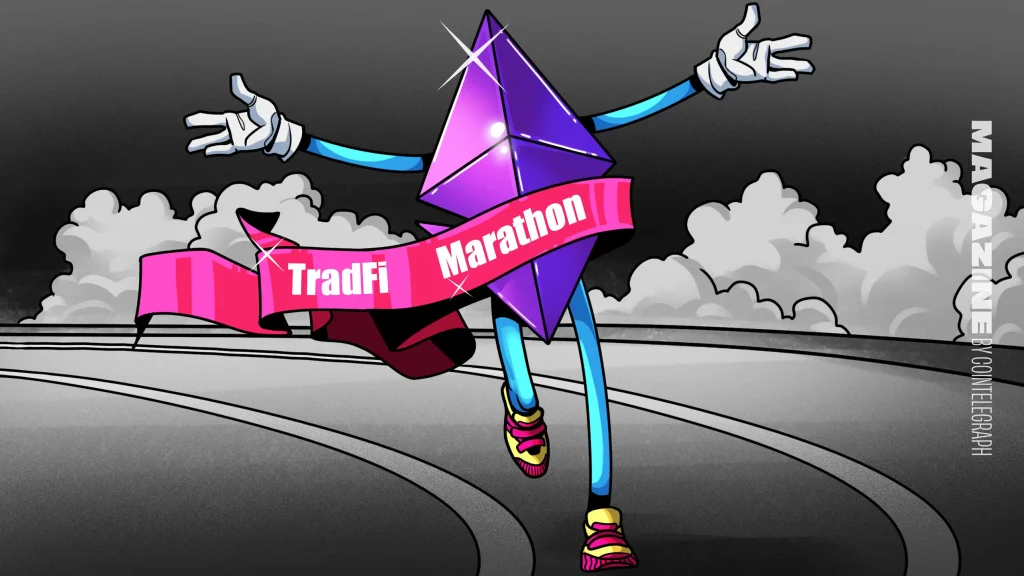|
|
For years, the default assumption in the Ethereum community has been that it will inevitably become the global settlement layer for finance.
It didn’t matter that retail was jumping ship for faster and cheaper chains like Solana and Aptos — TradFi would recognize that Ethereum is the most battle-tested, credibly neutral and decentralized network, making it the only viable option for what Boston Consulting Group predicts will be a $16.1-trillion market by 2030.

There are signs the prophecy is coming true. BlackRock, Fidelity, Wisdom Tree, Sony, Deutsche Bank, UBS and Coinbase are all making Ethereum the core of their onchain strategies. Last week, Ethereum-based platform Blocksquare announced a $1-billion deal with Vera Capital to tokenize US real estate, and Securitize and Ethena teamed up to launch the Converge L2 to tokenize billions more real-world assets (RWAs).
2025 is shaping up as the make-or-break year for Ethereum’s dominance of RWAs, with tokenized assets surging 57% to $21 billion since the US election set the stage for new crypto legislation that clarifies the rules.
But some warn that Ethereum might watch it all slip away if it doesn’t play its cards right.
Sam Kazemian, founder of stablecoin project Frax Finance, believes Ethereum really is the best place for institutions to issue RWAs — but that doesn’t mean it’s going to win.
“I think that the complacency of like, ‘It’s just gonna happen because Ethereum is so good,’ that’s not true,” he says, arguing that unless Ethereum maxis start positioning the blockchain as the only acceptable source of truth for tokenized assets, its advantages will slip away.
Kazemian says the fact that BlackRock’s BUIDL is available on seven different blockchains undermines Ethereum’s security advantages.
That’s because holders of the ETH version of an RWA token are exposed via the centralized issuer to the risks of the token on the other chains. As the issuer of Frax stablecoins (FrxUSD is actually backed by BUIDL), Kazemian knows Frax is liable for anything that happens to its coins on Binance Smart Chain, which could have flow-on effects for holders of the ETH version.

So if a tokenized RWA has a centralized issuer, does Ethereum’s exalted network security matter as much? After all there’s almost $70 billion of USDT on Tron, despite concerns over its decentralization.
As much as Kazemian dislikes Bitcoin maxis, he says they have been effective at zealously guarding Bitcoin’s status as the sole store of value in crypto by deriding everything else as a shitcoin. He says ETH maxis should do the same about RWAs issued on other chains.
So, do they need to start acting like assholes to win the TradFi tokenization race?
“Yeah… they’re too nice.” he says. “You have to clearly, socially, make the limits of tokenization that it HAS to be on Ethereum L1.”
“If we wanted to actually make Ethereum the ledger of truth, we would have to be a little bit abrasive and very annoying and unlikable in this area and force institutions to essentially put their money where their mouth is,” he says.
“If it’s on anything else, it’s bullshit.”
A post on April 14 by the Ethereum Foundation’s new co-director, Tomasz Stanczak, suggests the idea could gain traction. He wrote that a big priority for Ethereum will be to insist on the requirement to “always mint assets on the L1.”
Also read: Pectra hard fork explained — Will it get Ethereum back on track?
Ethereum is well ahead on every RWA metric

“Every stock, every bond, every fund — every asset — can be tokenized. If they are, it will revolutionize investing,” BlackRock chair Larry Fink.

To date, Ethereum has been the No. 1 choice for major financial institutions and their clients.
Even though BlackRock’s BUIDL is offered on Solana, Aptos and four other chains, 93% of its $2.4 billion in AUM is on Ethereum. Most of that flowed in during the past six weeks, even as bearishness about ETH sunk to new lows.
BUIDL requires a minimum investment of $5 million and investors don’t seem willing to risk that kind of capital on anything but Ethereum.
“There was no question that the blockchain we would start our tokenization on would be Ethereum and that’s not just a BlackRock thing. That’s the natural default answer,” BlackRock’s head of digital assets, Robbie Mitchnick, said in March.
“Clients have clearly made the choice that they really do value decentralization, credibility and security. And that is a great advantage that Ethereum continues to have.”
BlackRock's Head of Digital Assets, Robbie Mitchnick ft. Joe Lubin
The ticker is $ETHhttps://t.co/HoSukmSAQi pic.twitter.com/xd0mcH2JMm
— Etc. (@ec265) March 21, 2025
Backed by the Ethereum Foundation and Vitalik Buterin, Etherealize launched earlier this year to market the chain to Wall Street. Founder Vivek Raman says TradFi firms have very different priorities to retail traders.
“The ones that you see on Crypto Twitter, the ones you see trading meme coins, they’re the ones that don’t care as much about decentralization because you don’t really need that for those use cases,” he says.
“The more high-value the assets are, the more global the network, the more regulatory needs that the institution has, the more Ethereum’s decentralized, global value proposition shows itself.”
Ethereum dominates RWAs, stablecoins and DeFi
Ethereum currently accounts for 57% of all tokenized RWAs, and a further 21% is on ZKsync Era. The next largest competitors are a long way behind, with Stellar accounting for $476 million, or a 4.5% market share, Aptos with $332 million (3.2%), Algorand with $329 million (3.1%) and Solana with $301 million (2.9%).
Ethereum also has the highest economic security, settles 95% of stablecoin volume, and has seven times as much DeFi value locked as Solana.
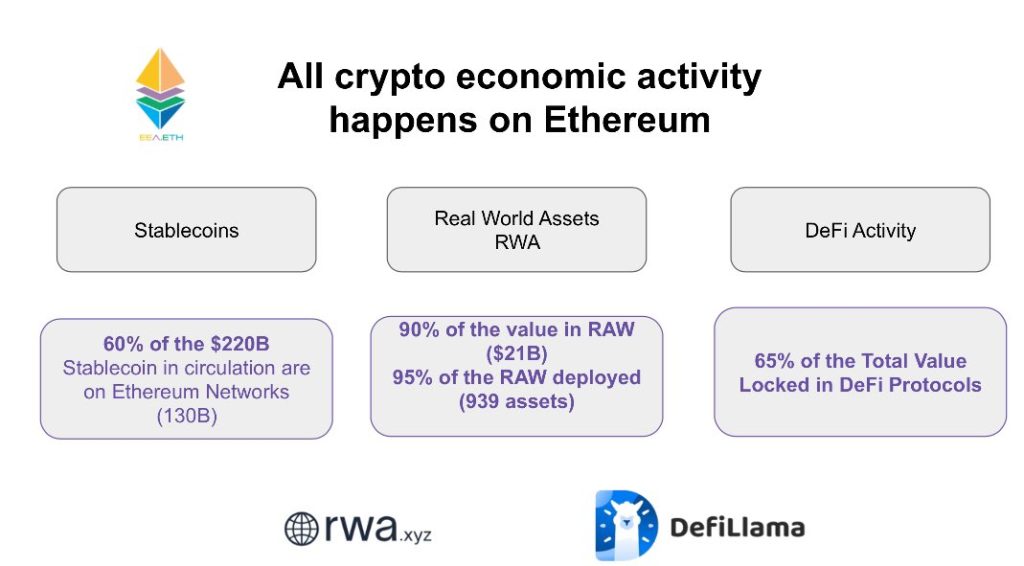
Henrik Andersson, founder of crypto fund Apollo Capital, says while decentralization and credible neutrality are great, Wall Street is more concerned with network effects, liquidity and composability.
“I’d argue 80% of activity across stablecoins and DeFi happens on Ethereum — this is in our view why Ethereum will be the natural home of TradFi assets. At the end of the day, there is little point in tokenisation if you’re creating a walled garden onchain on a ‘ghost chain.’”
But like many on social media, crypto educator and YouTuber DBCrypto, takes the opposite view.
“It may win some battles but there is zero chance that it will truly be the main tokenization layer long term,” he tells Magazine in an exchange on X.
“Other chains will catch up in terms of decentralization and some are arguably already there or close while offering a 100x improvement in everything else.”
“Ethereum is the Blockbuster or MySpace of crypto.”
Will Ethereum’s inability to scale hurt its RWA chances?
Ethereum’s base layer is slow by modern blockchain standards, with speed sacrificed to maintain decentralization.
Danny Chong, co-founder of Tranchess, tells Magazine that he foresees a split between major institutions like the European Investment Bank and Société Générale using Ethereum “as a secure, neutral base layer,” while high volume and retail facing RWA applications like real estate and private credit migrate to Solana or Aptos.
“TradFi institutions prioritize security, technical familiarity and regulatory confidence, which outweigh low-cost and fast transactions,” he says.
“Ethereum is likely to remain the ‘main highway’ for high-value institutional assets, while faster chains may capture smaller, high-volume segments.”
Given Solana’s strong focus on users and dominance among retail users, this seems like a real possibility.
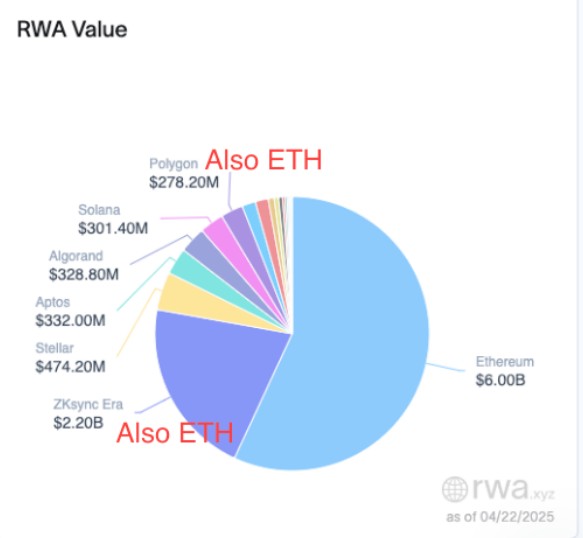
But Raman argues that L2s only have to focus on execution and don’t have to worry about network consensus, which means, “if you want the cheapest, fastest execution environment, that’s an L2,” he argues.
This is not true just yet, given most L2s have fewer than 100 TPS compared to Solana’s 4,000 TPS. But MegaETH recently achieved 20,000 TPS on testnet, and the Eclipse L2 (based on Solana VM) has achieved 8,000 TPS.
Raman adds that it’s more attractive for institutions to own and customise L2s and receive the fee revenue, rather than pay Solana validators to use their network.
“You can make a lot more money running your own layer 2 and plugging into the global Ethereum network,” he says. “I can’t think of a reason why it’s not better for an institution that wants to make money and maximize profitability versus using a different L1.”
Tradable has tokenized a couple of billion dollars worth of private credit on Ethereum L2 ZKsync. The rollup is also shifting to the new Rust and STARK-based BoojumVM that it claims will enable 10,000 transactions per second by the end of 2025.
Similarly, the largest RWA tokenization firm Securitize has just launched Converge L2, which uses Ethena’s alternative data availability and Arbitrum’s tech. It’s targeting almost 5,000 TPS.
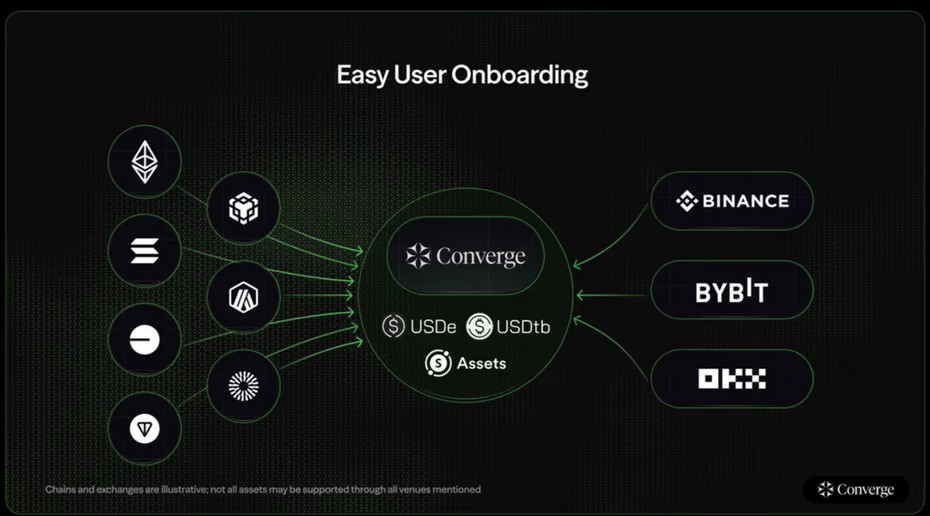
New security token standards could also help cement Ethereum’s lead, with ERC-3643 and ERC-1400 offering built-in compliance mechanisms for KYC, AML and transfer restrictions. In March, the Depository Trust & Clearing Corporation (DTCC) — which processed $3.7 quadrillion in securities transactions last year — began supporting the issuance and management of ERC-3643 tokens through its ComposerX suite.
This week (April 23), the DTCC will demonstrate its new digital collateral management platform AppChain, built using the Besu open-source Ethereum client.
Also read: What are native rollups? Full guide to Ethereum’s latest innovation
Ethereum winning RWAs but it’s still early days
With all of that said, TradFi’s flirtation with blockchain is still in its early stages. So, while Ethereum stans are celebrating the fact it accounts for $4.1 billion out of a total of $5.75 billion in tokenized US treasuries, those amounts pale next to the total value of outstanding US Treasurys of $28.6 trillion.
Marco Cora, director of the ZKsync Foundation, concedes we’re still in the early stages of the race.
“Today, we are like 0.1% of the market,” he says, envisaging a situation where a huge player backs a rival network. “JPMorgan, for the sake of argument, comes and says, ‘We’ll tokenize half a trillion that we custody all on Algorand,’ and all of a sudden Algorand goes to $500 billion [share of RWAs], and everyone else is $20 billion, and they now look [as if they comprise] 98% of the market,” he says.
But Cora doesn’t think that’s likely because credible neutrality is “very important for large enterprises.” He says they don’t want to build on a platform controlled by a competitor or by a centralized entity that could unilaterally change the rules, as Facebook and OpenAI have done to businesses built on their stack.
“If I’m Fidelity, why do I want to work with the JPMorgan platform? It’s a risk to me,” he asks.
“Ethereum looks and is today the most neutral of the places. And that is very powerful.”
Preaching Ethereum RWAs to Wall Street
But if traditional finance understands the benefits of the Ethereum network, they certainly don’t seem to be pouring money into ETH. After seven weeks of outflows, the ETH ETFs have just $4.57 billion in assets, while the Bitcoin ETFs have $94.5 billion.
Kazemian argues that a big issue has been the focus on valuing ETH like a tech stock, especially now that fee revenue is unable to justify the valuation. He believes it should instead be positioned as “digital silver” to Bitcoin’s “digital gold.”
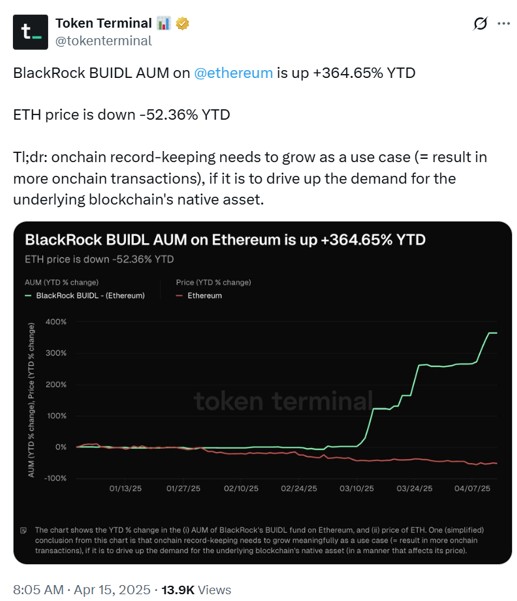
Former banker Raman agrees that Ethereum has a more complicated story to tell than Bitcoin.
“There is a way to simplify it. I think that it’s the way to play blockchain adoption. I think it’s the way to play stablecoin growth, and it’s a way to play tokenization,” he says. “All of that accrues value, ultimately to ETH the asset. But yeah, it’s definitely more complicated.”
The relative inflows into the Bitcoin and Ethereum ETFs, suggest Wall Street considers ETH a riskier bet than BTC. But the likely approval of staking for the Ether ETFs this year could provide an important point of difference.
“Tradfi views Bitcoin as digital gold,” Raman explains. “Like you said, maybe they view Ethereum as a worse store of value. I don’t think it’s intuitive that everyone knows ETH has a staking yield, but I do know that institutions and TradFi, the whole world, everyone loves yield, everyone loves fixed income instruments.”
Ramen cautions that a 3% yield is unlikely to bring in huge new inflows, but he says it can help change the narrative and show that “ETH is differentiated to Bitcoin because it has its yield, and then people can play with that yield. They can isolate it, they can swap, there’s all these financial instruments you can create on top of yield, which Wall Street loves to do, and it creates a backbone of an economy.”


Andrew Fenton
9 weirdest AI stories from 2025: AI Eye
